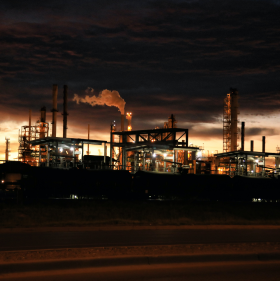The global oil industry, a cornerstone of the world economy, stands as a complex and influential entity. Its dynamics extend far beyond simple supply and demand mechanics, intertwining with a myriad of factors that shape the global economic landscape. To truly grasp the nuances of this industry, one must consider the multifaceted drivers that influence oil prices and their far-reaching consequences.
At the heart of oil price fluctuations are geopolitical events. For instance, the 2020 global oil price crash, catalyzed by the COVID-19 pandemic and exacerbated by the Russia-Saudi Arabia oil price war, sent shockwaves through the market. As reported by the U.S. Energy Information Administration (EIA), the West Texas Intermediate (WTI) crude oil prices even plummeted into negative territory in April 2020, a historic occurrence.
Technological advancements, particularly in the realm of shale oil extraction, have dramatically altered the oil supply landscape. The EIA noted that U.S. crude oil production reached a record high of around 12.2 million barrels per day in 2019, largely due to shale oil. This surge in production has not only reshaped the U.S.’s role in the global oil market but also introduced a new level of flexibility and unpredictability in oil supply.
Environmental policies and the shift towards renewable energy also play a significant role. The Paris Agreement, aiming to limit global warming, has spurred a global movement towards sustainable energy sources. This shift is gradually influencing oil demand patterns, with the International Energy Agency projecting a plateauing of oil demand in the 2030s.
Furthermore, market speculation in oil futures can lead to significant price volatility. The dynamics of futures trading often reflect investors’ expectations of future market trends, which may not always align with the actual physical supply and demand.
In summary, the economics of oil is a tapestry woven from diverse strands – geopolitical events, technological breakthroughs, environmental policies, and market speculation. These factors collectively orchestrate the global oil price narrative, impacting economies, businesses, and consumers worldwide.

The Basics of Oil Economics
The fundamentals of oil economics are deeply rooted in the principles of supply and demand, yet these dynamics are influenced by a range of complex factors at the global scale.

Supply Dynamics
The supply side of oil economics is significantly influenced by decisions made by OPEC+ (Organization of the Petroleum Exporting Countries and allies). OPEC+, as of 2021 data from the IEA, accounts for over 40% of the world’s crude oil production, giving it substantial influence over global oil supply and, consequently, prices. For example, OPEC+’s decision to cut production by 9.7 million barrels per day in April 2020 in response to the pandemic-induced demand slump had a notable impact on global oil prices.
Additionally, the rise of shale oil production, particularly in the United States, has added a new dimension to the supply dynamics. The U.S. Energy Information Administration reported that in 2019, the U.S. became the world’s largest producer of crude oil, largely thanks to shale oil, contributing to a shift in global supply dynamics and reducing OPEC’s influence on oil prices.

Demand Dynamics
On the demand side, industrial consumption and transportation needs are key drivers. The IEA’s 2021 report highlighted that the transportation sector accounts for approximately 60% of global oil demand, making it a significant factor in global oil consumption patterns. Additionally, industrial applications, particularly in emerging economies, contribute substantially to oil demand. The demand for oil is subject to economic growth trends and advancements in energy efficiency and alternative energy sources. For instance, the increasing adoption of electric vehicles poses a long-term potential threat to oil demand in the transportation sector.
In sum, the basic economics of oil are shaped by a delicate balance between supply, influenced by major producers and technological advancements, and demand, driven by global economic activities and technological shifts in energy consumption.
Geopolitical Factors Influencing Oil Prices
Geopolitical events have a profound impact on global oil prices, often leading to significant market volatility. Two notable events in recent history—the Russia-Ukraine conflict and the 2020 oil price crash—provide insight into how political dynamics can shape the oil market.
- Russia-Ukraine Conflict: The conflict between Russia and Ukraine, escalating significantly in 2014 and again in 2021, has had considerable repercussions on the global oil market. Russia, one of the world’s largest producers of oil, faced various sanctions from Western countries. According to the U.S. Energy Information Administration (EIA), Russia produced an average of 10.5 million barrels per day in 2020, accounting for 11% of the global oil supply. Sanctions and political tensions disrupted this supply, leading to heightened concerns about global oil security and contributing to price increases.
- Middle East Tensions: The Middle East, being another critical region for global oil supply, frequently influences oil prices through its political stability. Tensions in countries like Iraq, Iran, and Saudi Arabia can lead to fears of supply disruptions. For instance, the drone attacks on Saudi Aramco facilities in 2019 temporarily halted approximately 5% of the global oil supply, causing a spike in oil prices.
- 2020 Oil Price Crash: The oil price crash in 2020 during the COVID-19 pandemic and the Russia-Saudi Arabia price war serves as a stark example of geopolitical influence. In early 2020, as COVID-19 led to an unprecedented drop in demand, OPEC and its allies were unable to agree on production cuts. Russia and Saudi Arabia then entered a price war, with both nations increasing production to gain market share. This led to a supply glut at a time of collapsing demand. As a result, WTI crude oil prices fell to negative values for the first time in history in April 2020.
These cases illustrate how geopolitical factors, ranging from conflicts and political instability to strategic decisions by key oil-producing nations, can significantly impact global oil prices. The oil market’s sensitivity to such events underscores the need for continuous monitoring and strategic planning by industry stakeholders.

The oil and gas industry has been significantly reshaped by technological advancements, particularly in the realms of shale oil production and the transition towards renewable energy sources.
Shale Oil Revolution
The advent of hydraulic fracturing, commonly known as fracking, and horizontal drilling has revolutionized the oil industry, particularly in the United States. These technologies have enabled oil companies to access previously unreachable shale formations rich in oil and natural gas. According to the U.S. Energy Information Administration (EIA), U.S. shale oil production soared from about 0.5 million barrels per day in 2008 to approximately 7.7 million barrels per day in 2019, catapulting the U.S. into one of the world’s top oil producers. This surge significantly altered global oil markets, reducing the U.S.’s reliance on imported oil and influencing global oil prices. The U.S.’s role in the global oil market shifted from being a major importer to a significant exporter.

Renewable Energy Transition
Simultaneously, the global shift towards renewable energy sources is beginning to impact oil demand. This transition is driven by increasing concerns about climate change and a push for sustainable energy policies worldwide. Governments and private entities are investing heavily in renewable energy technologies such as wind, solar, and biofuels. The International Renewable Energy Agency (IRENA) reports that renewable energy capacity is set to increase by 50% between 2019 and 2024, with solar and wind energy leading the growth. As renewable energy becomes more cost-competitive and technologies advance, the demand for oil, particularly in the power generation sector, is expected to decrease. This shift poses a long-term challenge to the oil industry, urging it to adapt and seek new markets or innovations, such as carbon capture and storage, to stay relevant in the evolving energy landscape.
Global Environmental Agreements
The Paris Agreement, adopted in 2015, is a landmark in global climate efforts. It aims to limit global warming to well below 2, preferably to 1.5 degrees Celsius, compared to pre-industrial levels. This ambitious target necessitates significant reductions in greenhouse gas emissions, directly impacting the oil industry, a major source of CO2 emissions. According to the International Energy Agency (IEA), meeting the targets of the Paris Agreement could see oil demand peak and then decline over the next few decades. Countries partaking in the Agreement are increasingly implementing policies that discourage oil consumption, such as carbon pricing, subsidies for renewable energy, and regulations promoting energy efficiency.

Green Energy Initiatives
Alongside global agreements, the push for sustainable energy sources is shaping oil demand. Governments worldwide are supporting the development and adoption of renewable energy through various initiatives, including incentives for solar and wind energy and regulations favoring electric vehicles (EVs). The International Renewable Energy Agency (IRENA) reports a significant increase in renewable energy capacity, with renewables accounting for over 80% of all new electricity capacity in 2020. As the energy sector gradually shifts towards these cleaner sources, the demand for oil, particularly in power generation and transportation, is expected to diminish. The combined effect of global environmental policies and the push for green energy is leading to a paradigm shift in the oil market. The industry faces the challenge of navigating this new landscape, balancing the current demand with a future that increasingly leans towards sustainability.
Market Speculation and Oil Prices
The oil futures market is a critical component of global oil economics, often leading to significant price volatility. In these markets, traders buy and sell contracts for the future delivery of oil at a predetermined price. These contracts can be bought and sold multiple times before the actual delivery date, and their prices fluctuate based on market expectations and sentiment. One of the key factors contributing to price volatility in oil futures is market speculation. Traders often make bets on the direction they anticipate oil prices will go, based on various factors such as geopolitical events, supply-demand dynamics, and economic indicators. This speculation can lead to rapid price changes, as seen in April 2020 when U.S. crude oil futures plunged into negative territory for the first time in history amid a pandemic-driven demand collapse and storage capacity concerns.
Recent trends in oil futures markets have been influenced by a variety of factors. According to data from the U.S. Energy Information Administration, oil prices have experienced significant volatility in recent years, influenced by events like the COVID-19 pandemic, OPEC+ decisions, and geopolitical tensions. The future markets remain sensitive to such global events, underscoring their role in oil price determination.

The Role of OPEC+ in Oil Economics
OPEC+, which includes OPEC members and allied oil-producing nations like Russia, plays a pivotal role in global oil economics. This consortium controls a significant portion of the world’s oil supply and its decisions on production cuts or increases can have a substantial impact on global oil prices. Recent decisions by OPEC+ have been crucial in stabilizing oil markets, especially after the volatility caused by the COVID-19 pandemic. For instance, in April 2020, OPEC+ agreed to a historic production cut to stabilize falling prices due to plummeting demand. This decision had a significant impact, helping to gradually raise prices from their historic lows.
However, OPEC+’s influence is not absolute, and its decisions are often influenced by external factors, including geopolitical dynamics and market trends. The consortium’s decisions are closely monitored by market participants as they provide key indicators of future oil supply and, consequently, prices.
The Future of Oil Economics
Forecasting oil prices is a complex endeavor, involving the consideration of numerous variables including geopolitical events, technological advancements, and policy changes. Experts often use models that incorporate these variables to make informed predictions about future oil prices. For instance, the IEA provides regular forecasts based on current market data and trends.
As we look to the future, businesses and governments need to adapt to these economic trends. This includes diversifying energy sources, investing in renewable energy, and enhancing energy efficiency. For oil-dependent economies and companies, this could mean a strategic shift towards more sustainable and diverse energy portfolios. Adapting to changes in oil economics also involves embracing technological innovations and adjusting to new market realities, such as the increasing role of renewable energy. This adaptation is not only crucial for economic resilience but also for environmental sustainability, aligning with global efforts to combat climate change.

In conclusion, the economics of the oil market is a multifaceted and dynamic realm, influenced by a myriad of factors ranging from geopolitical shifts and technological advancements to environmental policies and market speculation. Understanding these complex interplays is crucial for stakeholders in the oil and gas industry, including Platform Ideas.
The volatility of oil prices, shaped by global events and market sentiments, highlights the importance of staying abreast of the latest developments. The strategic decisions of OPEC+, the impact of geopolitical tensions, and the evolving landscape of renewable energy sources are key elements that define the market’s direction. Additionally, the transition towards cleaner energy sources and the role of technological innovations cannot be overstated in shaping the future of this industry.
For Platform Ideas and similar entities, adapting to these economic dynamics is not just a matter of staying competitive but also of ensuring long-term sustainability in an industry that is at the cusp of transformation. As the world moves towards a more sustainable and diversified energy portfolio, the ability to anticipate and respond to these changes will be paramount. Therefore, it’s essential for stakeholders to remain informed and agile, ready to navigate the challenges and opportunities that lie ahead in the oil and gas sector.



